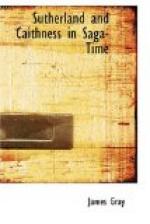Worsaae. The Prehistory of the North. London, Truebner, 1886.
Wyntoun’s Chronicle. Edinburgh, Edmonston & Douglas, 1872.
[Footnote 1: An excellent Bibliography of Caithness, by Mr. John Mowat, was published by W. Rae, Wick, in 1909, and of Caithness and Sutherland by The Viking Club, 1910, by the same author.]
[Footnote 2: The Capitals and abbreviations placed in brackets after certain authorities, give their initial letters and short titles, (e.g. (O.S.) Orkneyinga Saga), as used in the notes at the end of this volume.]
Early Sources of Scottish History, A.D. 500 to 1286,
by Alan O.
Anderson. Oliver & Boyd, Edinburgh.
Note.—Since this little book was printed, the above great work has appeared. To the student of the Norse invasions its value is inestimable.
[Transcriber’s note: The following errata have been applied to the text.]
ERRATA.
Page 1, line 13, for “they” read “Man.” " 28, line 9, for “or” read “of.” " 40, line 23, for “Kundason” read “Hundason.” " 42, line 24, after “note” reference[14] omitted. " 50, line 17, for “mainland of” read “Unst in.” " 65, line 35, for “burnings” read “revenges.” " 65, line 37, for “burnt” read “killed.” " 87, line 18, for “Earl Ragnvald” read “Jarl Ragnvald.” " 104, lines 4 and 5, for “Magnus’ great-grandson’s granddaughter’s husband” read “Magnus’ granddaughter’s great-grandson.” " 117, line 16, omit “a child of.”
Sutherland and caithness in saga-time
or,
the jarls and the Freskyns.
CHAPTER I.
Introductory.
In the following pages an attempt is made to fit together facts derived, on the one hand, from those portions of the Orkneyinga, St. Magnus and Hakonar Sagas which relate to the extreme north end of the mainland of Scotland, and, on the other hand, from such scanty English and Scottish records, bearing on its history, as have survived, so as to form a connected account, from the Scottish point of view, of the Norse occupation of most of the more fertile parts of Sutherland and Caithness from its beginning about 870 until its close, when these counties were freed from Norse influence, and Man and the Hebrides were incorporated in the kingdom of Scotland by treaty with Norway in 1266.
References to the authorities mentioned above and to later works bearing on the subject have been inserted in the hope that others, more leisured and more competent, may supplement them by further research, and convert those portions of the narrative which are at present largely conjectural from story into history.




